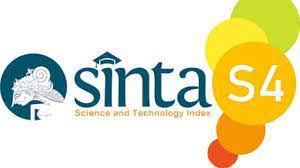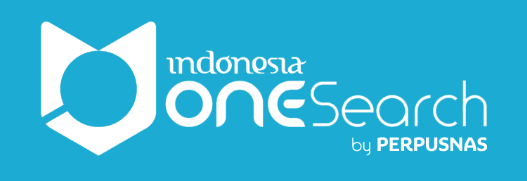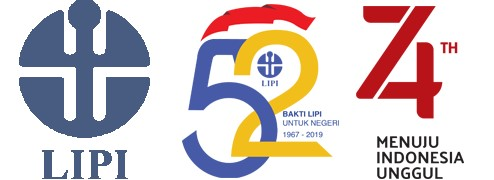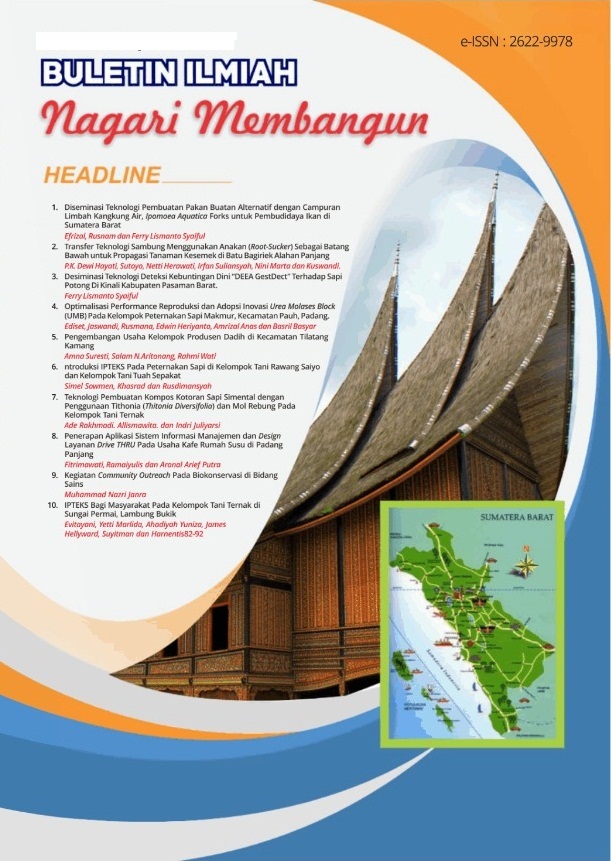EDUKASI TANAMAN OBAT SEBAGAI BANK HERBAL NAGARI DALAM REVITALISASI TAMAN TOGA DI NAGARI AMBUANG KAPUA KABUPATEN PADANG PARIAMAN
Abstract
Family Medicinal Plants (TOGA) are plants that can be used for health and are grown in the yard and managed by the family. These plants are grown to meet the needs of the family for medicines for prevention and daily treatment that can be self-processed. Apart from being a medicinal plant, the use of most of these plants also often doubles as a kitchen spice and ornamental plant. Community enthusiasm for the TOGA Park in Nagari Ambuang Kapua, Padang Pariaman District is quite high. From the survey, it was found that there are many large and empty yards of residents' houses in this Nagari. Meanwhile, in the TOGA Park itself, the diversity of medicinal plant species is very limited to certain species, especially those used for cooking spices only. Medicinal plants are sometimes replaced by the presence of ornamental plants. For TOGA to be utilized by the whole community, it is necessary to develop it through rearrangement and adding to the diversity of medicinal plant species. In the initial stage, planting is concentrated in one wider location. The activities were managed by the local community, especially PKK women who were accompanied by TOGA Activists and the Andalas University Team. It is hoped that the development/propagation of plants in a variety of species will create new TOGA gardens in every yard of residents' houses and be used by the community in the fields of health, aesthetics, and the economy. Family Medicinal Plants can provide benefits to society if cultivated in the right way. The activity was carried out by direct practice with the community at the park location accompanied by TOGA Activists with the Andalas University Team. This activity also received an award rating in the creative park competition at the local sub-district level in the Republic of Indonesia Anniversary competition.
Downloads
References
Erlindawati. (2015). Survei Pengetahuan Masayarakat Tentang Tanaman Obat Keluarga Puskesmas Air Tabit. Jurnal Photon, 6(1), 115–118. https://doi.org/10.37859/jp.v6i01.490
Fitriani, A., & Fitriani, Y. A. (2021). Pemanfaatan Toga Untuk Meningkatkan Kesehatan Dan Ekonomi Masyarakat Di Sekitar Lahan Basah. Prosiding Nasional Pengabdian Kepada Masyarakat, 3. Retrieved from http://snllb.ulm.ac.id/prosiding/index.php/snllb-abdimas/article/view/594
Fitriatien, S. R., J., N. E., Rachmawati, N., Rahmah, D. A., Safitri, M. R., Pahlevi, & Natsir, N. M. W. (2017). Kegiatan Penanaman Tanaman Obat Keluarga (Toga) Sebagai Salah Satu Usaha Pemberdayaan Siswa Sdn Dermo Guna Dalam Menumbuhkan Kepedulian Kesehatan Keluarga. Abadimas Adi Buana, 1(2), 21–28. https://doi.org/10.36456/abadimas.v1.i2.a949
Harefa, D. (2020). Pemanfaatan Hasil Tanaman Sebagai Tanaman Obat Keluarga (TOGA). Madani, Indonesian Journal Of Civil Society, 2(2), 28-36. https://ejournal.pnc.ac.id/index.php/madani/article/view/233/127
Kusumawaty, Y., & Khaswarina, S. (2018). Peningkatan Motivasi Ibu Rumah Tangga Untuk Memanfaatkan Tanaman Obat Keluarga (Toga). Buletin Udayana Mengabdi, 17(1), 7–13. https://doi.org/10.24843/bum.2018.v17.i01.p02
Lestari, S., Roshayanti, F., & Purnamasari, V. (2019). Peningkatan Ekonomi Keluarga Melalui Pemanfaatan Tanaman Toga Sebagai Jamu Keluarga. International Journal of Community Service Learning, 3(1), 22. https://doi.org/10.23887/ijcsl.v3i1.17486
Muttaqin, F. Z., Aligita, W., Muhsinin, S., Juanda, D., & Asnawi, A. (2018). Desa Mitra dalam Budidaya Tanaman Obat Keluarga Menuju Desa Cibiru Wetan sebagai Sentra Herbal. Jurnal Pengabdian Pada Masyarakat, 3(2), 159–164. https://doi.org/10.30653/002.201832.59
Nurmiati, N., Prastika, O. Y., & Fadhlan, M. F. (2019). Membantu Nagari Membangun Di Aur Kuning Kecamatan Pasaman Kabupaten Pasaman Barat. Buletin Ilmiah Nagari Membangun, 2(1), 202–210. https://doi.org/10.25077/bina.v2i1.95
Syaiful, F. L. (2018). Diseminasi Teknologi deteksi kebuntingan dini “Deea Gestdect” terhadap sapi potong di Kinali Kabupaten Pasaman Barat. Jurnal Hilirisasi IPTEKS, 1(3). https://doi.org/10.25077/jhi.v1i3.a.126





















